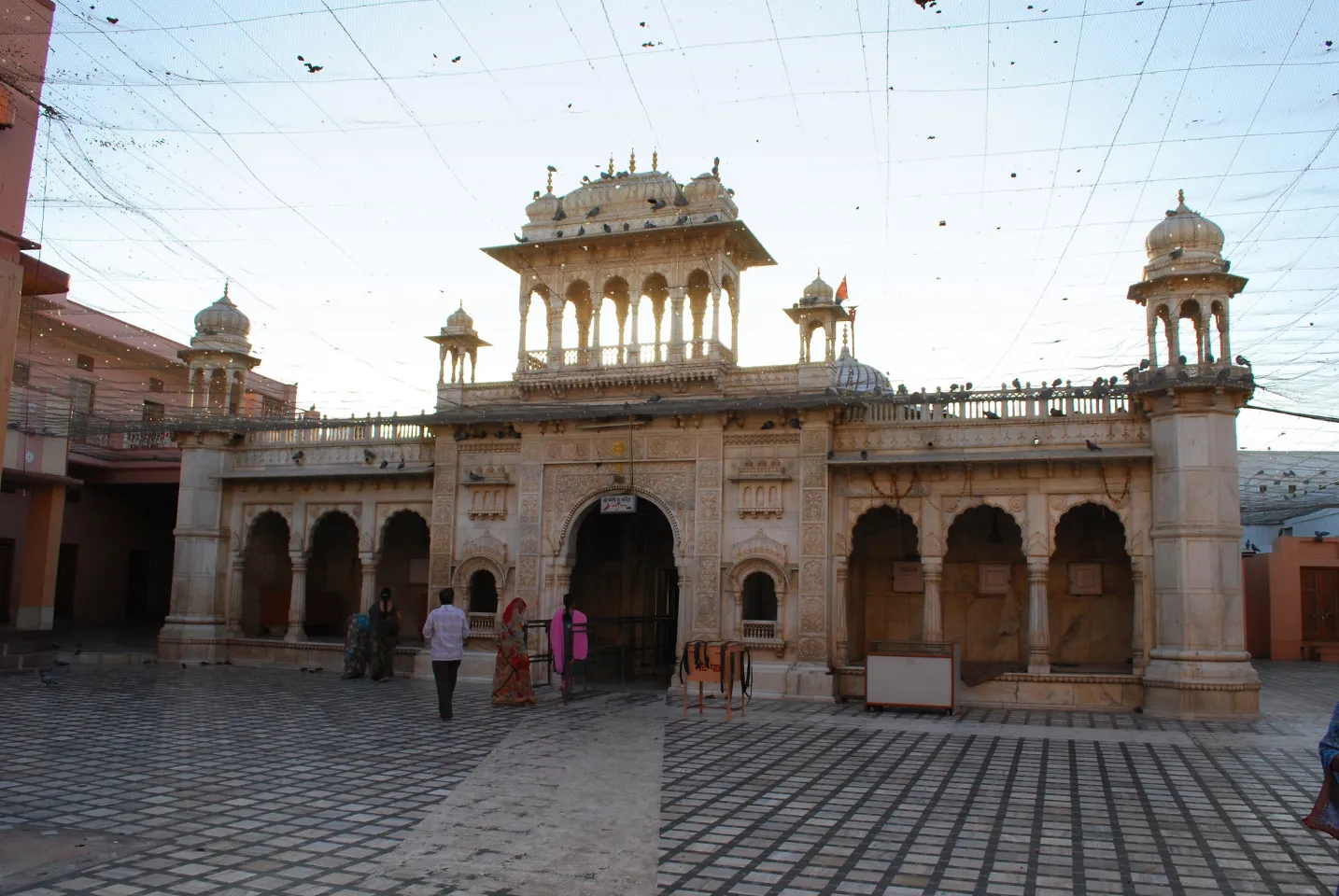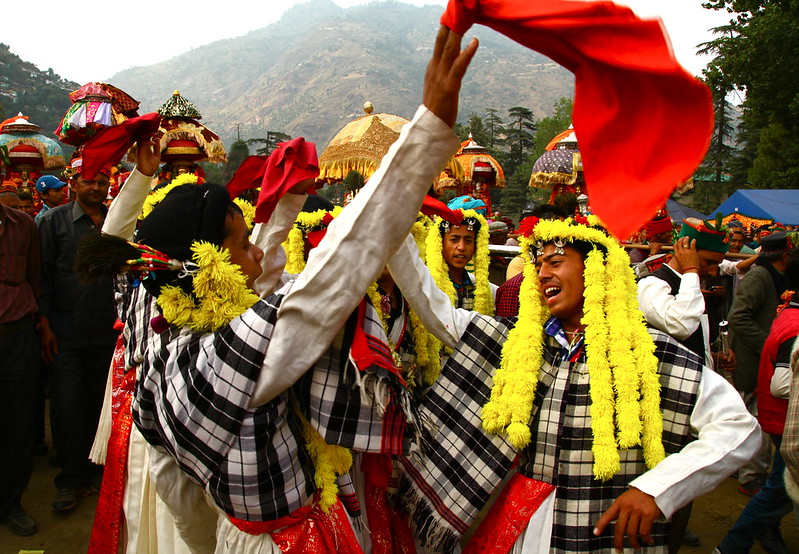As late June approached, my best friend Keisha, who had recently tied the knot, extended a warm invitation for me to visit her home in Goa. The mere thought of pristine turquoise seas, swaying palm trees, sun-soaked afternoons, refreshing coconut drinks, lively parties and indulgent sips of urrak instantly filled my mind with anticipation. Eagerly, I gathered my belongings and embarked on an exciting road trip to Goa, with Savaari as my trusted companion.
Upon reaching Keisha’s abode in Assonora, I couldn’t contain my excitement. “What adventures awaited us? Which club were we heading to?” I inquired. To my surprise, Keisha gazed at me with a mischievous smile and calmly uttered, “We’re going to jump into a well.” Stunned and bewildered, I couldn’t help but question her intentions. Was she joking? However, both Keisha and her husband were dead serious. My confusion mounted as I struggled to grasp the concept of willingly jumping into a well. Sensing my bewilderment, Keisha reassured me, assuring me that they had no intentions of forcibly pushing me into any well. Instead, she revealed that it was the Sao Joao Feast—a vibrant celebration where locals enthusiastically leap into wells as part of an age-old tradition.
Intrigued by this unique spectacle, my curiosity grew exponentially, and I couldn’t help but embrace the unexpected adventure that awaited me.
Decoding the Origins behind well jumping in Sao Joao Festival
Seeking clarification for the seemingly unusual ritual of jumping into a well, I asked Keisha for an explanation. Sensing my perplexity, she told me this age-old tradition had deep historical roots. Intrigued, I listened intently as she wove a tale of symbolism surrounding the ancient practice of jumping into wells. This courageous act was rooted in a profound story from biblical times when the Blessed Virgin Mary visited her cousin Elizabeth, who carried the unborn St. John. In an awe-inspiring moment, the unborn St. John leapt with pure joy in his mother’s womb upon hearing the news of Mary’s miraculous pregnancy with Jesus. Goans enact this historical event symbolically by ‘leaping’ into a water body.

The Sao Joao Feast in Goa aligns with the onset of the monsoon season, when nature flourishes with lush greenery and blooming flowers, and water bodies, including wells, are replenished. Against this backdrop, the celebration of the birth of St. John in Goa took shape, intertwining with the jubilation of the rainy season itself. This tradition also alludes to the baptism of Jesus in the river Jordan, emphasising the spiritual significance associated with water.
Enveloped in the rich tapestry of Goan customs and legends, I couldn’t help but feel a surge of reverence for the Sao Joao Feast and its deep-rooted significance.
Traditions that soar – Discovering the rituals of Sao Joao
I saw a captivating sight after attending the special Church prayer services at a nearby church. I saw many individuals, spanning various generations and genders. Their heads were adorned with splendid crowns from blooms and palm leaves. They traversed from house to house, joyously proclaiming with exuberance, “São João! São João!” I had no idea what was going on; it was like stepping into a whole new world. I was completely intrigued, confused, and dying to know more about this fascinating tradition.
Accompanied by Keisha’s family, I returned to their home, where the air was brimming with excitement to commence the day’s rituals. Filled with curiosity, I eagerly sought answers to my lingering questions. Why were the people in the community going from house to house? And why were they wearing flower crowns?
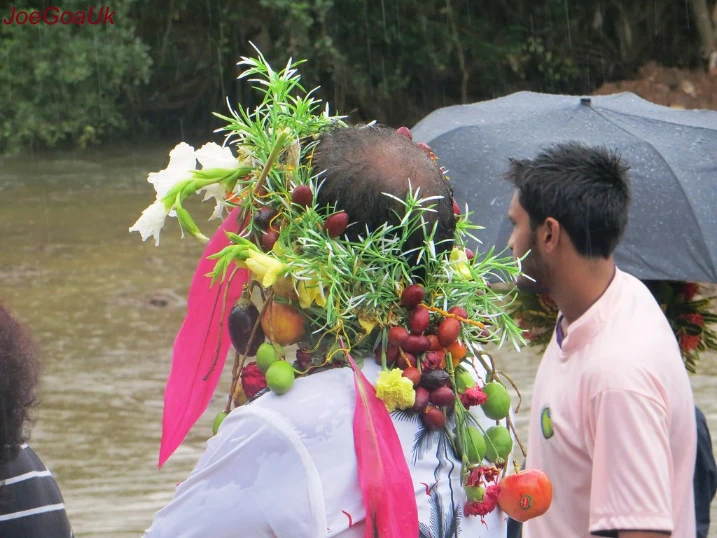
Kopels – Craftsmanship of exquisite floral crowns in Goa
As I descended the stairs, a captivating sight greeted my eyes. Keisha’s mother, with nimble fingers, meticulously crafted something enchanting out of vibrant flowers, delicate creepers, and verdant leaves plucked from the surrounding gardens. Curiosity getting the better of me, I couldn’t resist inquiring about her captivating creation. With a gentle smile, she revealed that she was fashioning “kopels“—exquisite handmade wreaths that gracefully adorn their wearers’ heads.
She told me that the crown on the head symbolises new life with the monsoon. Life in nature with the coming of the rains, green leaves and fresh flowers are now in abundance as the earth turns verdant. The crown is also symbolic of the crown of the martyrdom of John the Baptist. My mind was blown. At that moment, I couldn’t help but feel a profound sense of wonder and admiration. The beauty of the symbolism touched my soul, evoking a deep appreciation for the interconnectedness of life, seasons, and devotion. It was a powerful reminder of the extraordinary depths of human traditions and the sheer magic they can hold.
Vogue – A feast for the senses
Later on, she enlightened me with another intriguing aspect of São João. She told me that São João is an occasion for the family to get to know their newlywed daughters’ husbands better. At first, I couldn’t fathom how jumping into wells could facilitate this process. It seemed perplexing to me. However, she assured me that the meaning behind it ran much deeper than a mere physical act. Traditionally, the mother of a newly-married girl would send kopels to her son-in-law’s home. This is accompanied by a delightful assortment of Goan delicacies, locally known as Vogue.
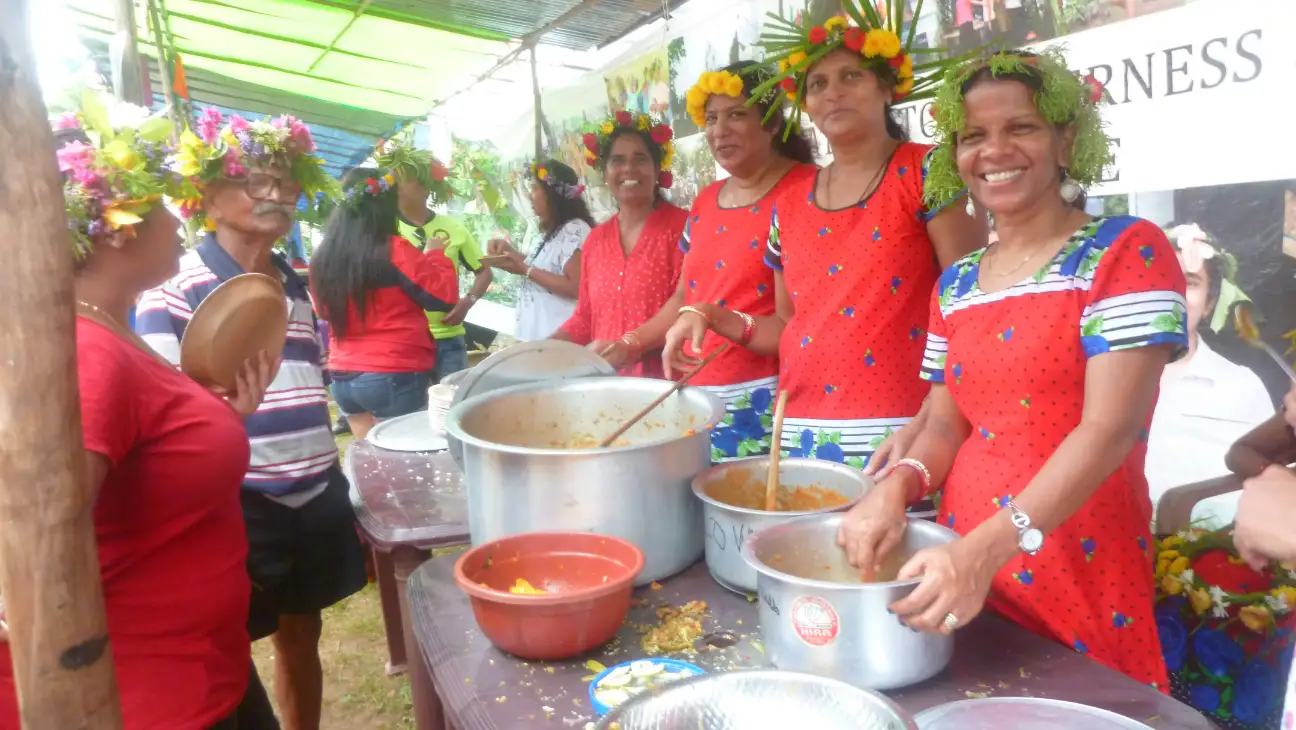
This includes sorpotel(Indian pork dish), sannas(steamed rice cake), and an array of traditional fruits and sweets. The son-in-law proudly adorned these floral crowns while savouring the delectable feast within the confines of their home. However, they shared the sweets and fruits with those who joined them in the joyous celebration as they danced to their hearts’ content.
To my delight, Keisha’s mother gave me a gracious gift—a kopel. She explained that nowadays, everyone wears kopels, transcending their original symbolism. With a Kopel adorning my head, I eagerly anticipated the forthcoming festivities. I was ready to immerse myself in this enchanting celebration of faith, love, and joy.
A spirited procession – Bustling streets and harmonious melodies
After relishing a delectable lunch of sannas and sorpotel, the atmosphere brimmed with joyful anticipation. Friends, family, and neighbours congregated, adorning themselves with vibrant kopels, ready to embark on a delightful adventure. Together, we ventured out onto the bustling streets, a lively procession illuminated by smiles and laughter. In unison, our voices united, singing the São João song in Konkani. Though unfamiliar initially, the infectious spirit swept me away, and I joined in the melodic chorus. Thankfully, my basic knowledge of Konkani made it easier for me to catch the groove of an already catchy tune.
We embarked on a joyful journey through our neighbourhood, visiting each neighbouring family. Warmly welcomed, they extended their hospitality, offering us “copache“—a great shot of urrak or feni, accompanied by plump mangoes and luscious jackfruit. Once again, I found myself taken aback by the neighbours offering boozy beverages with zero judgment. At that moment, I was reminded of how my own neighbours would take an act like this and turn it into hot gossip. However, here it was an integral part of the Sao Joao celebration. They embraced with open hearts and a sense of community.
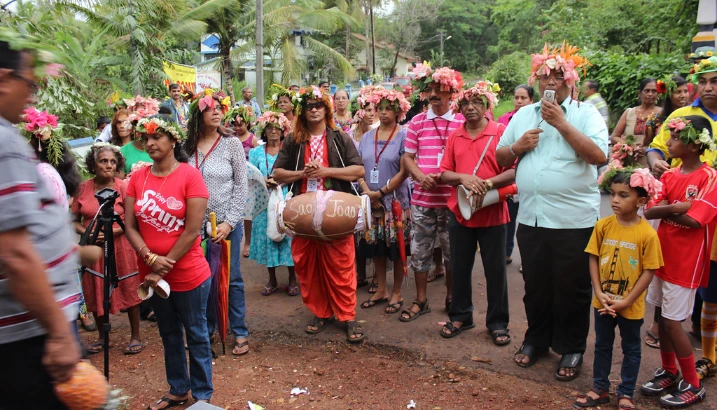
Sensing my hesitation to consume the shot fearing judgment by the elderly, one of the aunts kindly encouraged me, saying, “Come on, you have to do it! For a fantastic Sao Joao experience, you need that refreshing shot to keep your energy and spirits flowing all day long.” Her words resonated with me, highlighting the significance of this tradition and the freedom to let go of inhibitions. Our joyful procession eventually led us to a well, a gathering point where revelers embraced the exhilarating tradition of jumping in.
Splashing into joy – Well jumping in São João celebration
A palpable sense of excitement permeated the atmosphere as we eagerly observed the spectacle unfolding before us. With bated breath, we watched as people, accompanied by the rhythmic beats of gummot (drums) and cansaim (cymbals), fearlessly leapt into the well.
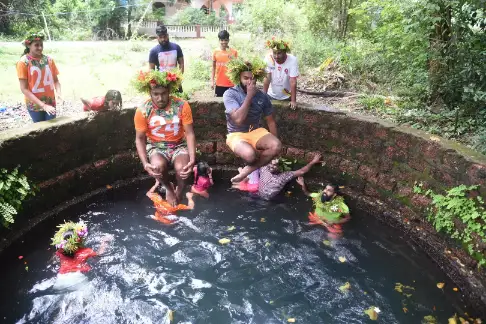
The anticipation of retrieving the gifts playfully tossed in by the enthusiastic villagers drove the participants. Their triumphant shouts of “São João! Viva São João!” echoed through the air, filling our hearts with exuberance. As I watched Keisha’s husband, Aaron, take the courageous leap into the well, an initial wave of fear washed over me. However, my apprehension quickly transformed into awe as he emerged from the depths, jubilantly shouting, “Viva São João!” with a gift in his hand. He was soon joined by other enthusiastic participants, including Keisha herself. Witnessing this incredible sight was an experience, unlike anything I had ever seen before. Their enthusiasm was infectious, spreading like wildfire among those witnessing the exhilarating scene. As I stood there, captivated by their unbridled joy, I couldn’t help but marvel at the remarkable display of spirit and camaraderie.
Sangodd – A mesmerizing boat parade
After that, we made our way to Siolim, where the main highlight of the day, the “Sangodd”, or boat parade, took place beside the Chapora River. Many villages represent themselves by sending these unique boats. The sight was mesmerizing, with vibrant boats adorned with colourful flowers and designs like guitars, birds, fruit baskets, sea creatures, mythical creatures, snakes, and dragons. As we stepped onto the boats, we joined the other members of the Sangodd, all dressed in a uniform that distinguished us from other groups. It was a wonderful experience to be part of this tradition, singing hymns while floating on the serene lake.
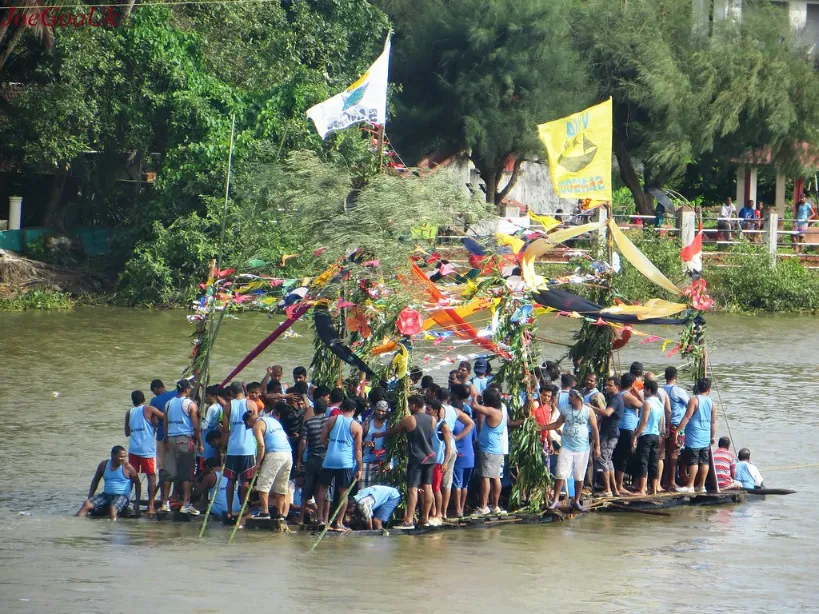
Alongside the decorated boats, we also noticed floating platforms constructed by joining two boats or banana trunks adorned with coconut palms. These platforms added to the festive atmosphere, creating a picturesque scene on the water. The youngsters among us eagerly participated in the various competitions held during the day, showcasing their talents and adding excitement to the Sao Joao celebrations.
If you plan to attend the Sangodd during the Sao Joao festivities in Goa in June, it’s essential to keep in mind the following details:
- The festival officially starts at 3:30 PM.
- The first boat usually arrives at the riverside church around 4 PM.
- The last boat typically reaches its destination by 5:30 PM.
- Each year, approximately 6-7 boats are participating in the festival.
- The boats are relatively small and accommodate around 8-10 people.
- Each boat has a name that represents the respective group or village.
When preparing to witness this vibrant celebration, consider these timings and the scale of the boats to make the most of your Sao Joao experience. It is advisable to book Savaari’s dependable taxi to reach your destination in Siolim. It is highly recommended to make your booking in advance to ensure a smooth and convenient travel experience.
Viva São João – Cherishing the festive finale
As the festivities drew close, the revellers and merry-makers congregated around the revered cross, forming a collective assembly. United in spirit and devotion, they harmoniously raised their voices to sing the ladain. This heartfelt litany is a form of prayer used in services and processions dedicated to Our Lady, a common title given to Mother Mary as a sign of respect and honour.
The air became infused with a sacred aura, enveloping us in reverence and faith. Following the soul-stirring litany, a cherished tradition unfolded—the distribution of traditional sweets. Among the delightful offerings was Ponnsa hole, a delectable pancake crafted from rice flour, delicately wrapped in a fragrant jackfruit leaf, and lovingly filled with an irresistible blend of coconut grating and jaggery. A rice cake, expertly prepared by combining mashed jackfruit with rice, also graced the gathering. These culinary delights, steeped in tradition, were shared among the attendees, further fostering a sense of togetherness and celebration.

This captivating experience opened my eyes to the multifaceted beauty of Goa beyond its famous party scene. It revealed a tapestry of vibrant culture and cherished rituals intricately woven into the fabric of everyday life. The Sao Joao festival in Goa, in particular, emerged as a testament to the indomitable spirit and unbreakable bonds of camaraderie that define Goan traditions. Leaving Goa with these newfound insights, I carried with me a profound appreciation for the diverse and vibrant tapestry of Goan culture. The feast of São João illuminated the true heart and soul of Goa, leaving an indelible impression on my spirit.
How to plan your trip to Goa for Sao Joao
Planning your trip for the Sao Joao festival in Goa can be an exciting and fulfilling experience. Here are some key points to consider that will help plan your trip:
When will Sao Joao take place in 2023?
In North Goa, the Sao Joao Festival is commemorated each year on the 24th of June, which falls six months before the birthday of Jesus on the 25th of December.
Where does Sao Joao take place?
The Sao Joao festival is observed throughout Goa, with North Goa hosting particularly extensive celebrations, especially in the Bardez Taluka. In this area, coastal villages such as Siolim, Anjuna, Calangute, and Vagator partake in grand festivities to mark the Sao Joao Feast. Additionally, other locales like Fernandes Vaddo, Marna, Igrej Waddo in Siolim, and Gaunsavaddo also actively participate in the celebration.
I highly suggest visiting Siolim to witness the festivities, as it provides a wonderful opportunity to experience the vibrant celebrations of the Sangodd near the Chapora River.
How to reach Siolim

By air
Goa International Airport in Dabolim is the nearest airport to Siolim. The airport is well-connected with flights from major cities across India. Situated approximately 49 kilometres away, it takes around 1 hour to reach Siolim from the airport. For a hassle-free transportation experience, it is recommended to book an airport taxi, ensuring a convenient ride to your accommodation.
By train
Thivim railway station is the closest railway station to Siolim. It serves as one of the main railway stations for North Goa. It takes approximately 28 minutes to reach Siolim from Thivim railway station. The most convenient mode of transportation is to book a car rental in Thivim, ensuring a smooth and comfortable journey to your destination in Siolim.
By road
Siolim enjoys excellent connectivity by road from major cities across India. Booking a cab is the optimal way to travel to Siolim, ensuring a comfortable and convenient journey. If you happen to be in Bangalore, consider booking a Savaari with an expert chauffeur to Siolim. It offers an enjoyable road trip experience. You can also enjoy exploring the vibrant city of by booking car rentals in Goa with a local driver who will take you to all the hidden gems, from its bustling tech parks to its picturesque parks and gardens.
Useful travel tips for an unforgettable Sao Joao experience in Goa
To make the best out of your Sao Joao experience, here are some helpful travel tips to keep in mind:
Timing: The Sao Joao festival in Goa takes place annually on 24th June. Therefore, plan your visit accordingly to coincide with the festivities. Check out all the details of the Sao Joao festival in the official Goa Tourism place.
Accommodation: It’s advisable to book your accommodation well in advance. This will be helpful if you’re planning to stay in popular areas like Siolim or Bardez Taluka. Goa offers a wide range of options, from luxurious resorts to budget-friendly guesthouses.
Festival schedule: Familiarise yourself with the festival schedule, including the timing of the Sangodd procession, talent competitions, and other events that interest you. This will help you plan your itinerary accordingly.
Explore beyond the festival: While Sao Joao festival in Goa is a highlight of your trip, don’t miss out on exploring the other attractions that Goa has to offer. Exploring the picturesque villages and coastal areas adds an extra layer of charm to the overall experience. You can further enhance your travel experience in Goa by checking out a comprehensive travel guide featuring the best things to do in the region. You’ll realise that there is so much more to Goa than meets the eye, including hidden gems like the Cabo de Rama Fort.
Local customs and etiquette: Familiarise yourself with the local customs and etiquette to show respect and immerse yourself in the Goan culture. Learn a few basic phrases in the local language, Konkani, to enhance your interactions with the locals.
The Sao Joao festival in Goa offers a captivating glimpse into Goa’s rich heritage. It presents a wonderful opportunity to witness unique customs and rituals. However, while visiting Goa, finding a taxi can sometimes be a challenge. To ensure a seamless trip, it is highly recommended to download Savaari’s car rental app. With the app, you can conveniently book a reliable chauffeured cab of your choice in advance and even enjoy discounts. This way, you can navigate through Goa with ease and have a stress-free transportation experience. It will allow you to fully enjoy the festivities and all that Goa has to offer.
Last Updated on January 17, 2024 by Swati Deol



